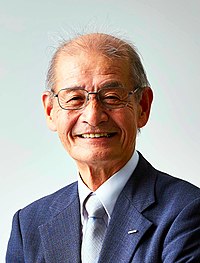|
Vikidia currently has 4,626 articles. Improve it! |
|
Join Vikidia: create your account now and improve it! |
Akira Yoshino
Akira Yoshino (born 30 January 1948) is a Japanese chemist. Who is a Fellow of Asaji Kasei Corporation and a Professor at Meizo University. He is said to be the father of modern lithium ion batteries used in mobile phones and laptops. He won the Nobel Prize in Chemistry in 2019.
Early life and education[edit | edit source]
Akira Yoshino was born on January 30, 1948, in Suite, Japan. He graduated from Kyoto University in 1970 and graduated in 1982 with a doctorate from Osaka University.
Career[edit | edit source]
- 1982: Kawasaki Scientific, Asahi Kasei Corporation, lithium ion batteries, etc.
- 1992: Manager, Product Development Team, Ion Battery Business Development Department, Asahi Kasei Corporation.
- 1994: Manager, Technology Development, A&T Battery Corporation, (joint venture of LIB Manufacturer, Asahi Kasei and Toshiba)
- 2003 – present: Fellow, Asahi Kasei Corporation / research on next-generation technology
- 2005 – present: General Manager, Yoshino Laboratory, Asahi Kasei Corporation Law / Advanced Battery Research.
Inventing secondary lithium ion batteries[edit | edit source]
In 1981, Akira Yoshino began research on rechargeable batteries using polyethylene. Polyethylene is a type of electromagnetic polymer that Hideki Shirakawa invented and later won the Nobel Prize in Chemistry in 2000 for his discovery.
In 1983, Yoshinop used lithium cobalt oxide (LiCoO2) (discovered by Godshell and his team at Stanford University in 1989, and John B. Goodenough and Koichi Mizushima at Oxford University) as a cathode and polycetallene as an anode. This type of battery had no lithium at the anode and here came the charging of the lithium ion cathode from LiCoO2 to the anode, which was the pioneer of modern lithium ion batteries.
The density of polyethylene is very low which would cause problems in the functioning of the battery. As a result, Yoshino used carbon dioxide at the anode, and in 1985 he developed and patented the first prototype lithium ion battery. This is how the modern lithium ion battery was born.
Sony introduced the battery in 1991 and A&T Battery (a joint venture between Asahi Kasei and Toshiba) in 1992.
Yoshino discovered that carbonaceous matter is suitable for anodes. Yoshino foil develops current collectors. Which ensured the availability of high voltage at low cost. In addition, positive thermal coefficients were used for additional protection in the battery.
In 1989, Yoshino approved the manufacture of lithium ion batteries. His battery was better than the previous lithium ion battery. U.S. authorities tested the battery and suggested that it was different from the metal lithium batteries used at the time.
